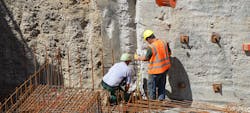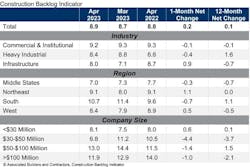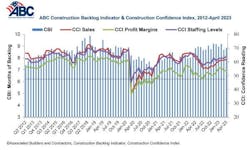The average U.S. contractor has 8.9 months worth of construction work in the pipeline, as of April 2023
Associated Builders and Contractors' Construction Backlog Indicator increased to 8.9 months in April from 8.7 in March, according to an ABC member survey conducted April 20 to May 3. The reading is 0.1 months higher than in April 2022.
After declining to a seven-month low in March, backlog rebounded in April due to strength in the infrastructure category. Regionally, backlog increased in the Northeast and West but fell in the South and middle states.
ABC’s Construction Confidence Index reading for sales and staffing moved higher in April, while the readings for profit margins inched lower. All three readings remain above the threshold of 50, indicating expectations of growth over the next six months.
“Based on ABC member sentiment, one would not be able to discern that interest rates are high, the nation’s banking sector is in tumult, politicians are arguing over the nation’s debt limit and recession fears remain pervasive,” said ABC Chief Economist Anirban Basu. “Despite many headwinds and an active news cycle, contractors continue to express confidence in the near term.
“Still, there is some evidence of a shift,” said Basu. “With credit conditions tightening, expectations are that private construction is poised for weaker times ahead. Nonetheless, backlog expanded in April, as infrastructure contractors began to take on more public works projects. Moreover, despite rapidly rising compensation costs, more ABC contractors expect profit margins to expand as opposed to recede over the next six months, evidence of sufficiently strong demand for construction services to support pricing power.”


